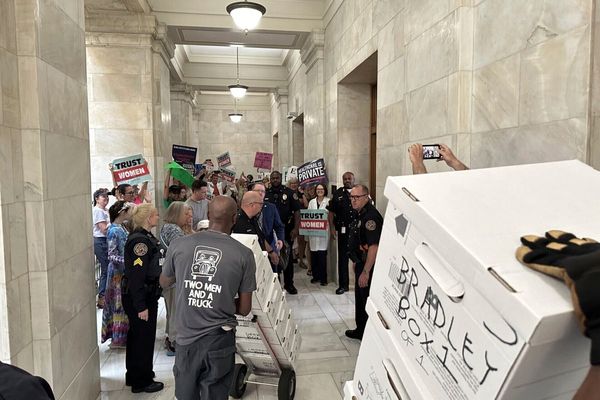
The Bureau of Meteorology has defended its forecasting against criticism it failed to give the coastal Queensland community of Harvey Bay enough notice of a torrential downpour in the aftermath of Tropical Cyclone Alfred.
The Fraser Coast mayor, George Seymour, said the bureau should review its systems, claiming the area was not adequately warned before it was pelted with more than 260mm of rain in a few hours on Sunday, sparking an emergency situation and about a dozen rescues.
But senior forecaster Christie Johnson on Monday argued “the bureau operated well”.
“We’ve had broad areas under warning, and we’ve tried to reduce those areas under warning as we’ve received greater guidance and the appeared threat areas have reduced,” she said.
The Queensland premier, David Crisafulli, said there was a very tense 24-hour period for many in south-east Queensland during Sunday and Monday, with hundreds of millimetres of water falling in creeks and streams.
“To give you an indication of the response and scale of the operation in the last 24 hours, there’s been 3,676 calls to help for the SES; that is the largest 24-hour period in the history of Queensland State Emergency Service,” he said.
The Queensland Fire and Emergency Services deputy commissioner Kevin Walsh said one swift water team had made a rescue at Palmwoods, on the Sunshine Coast, on water 300 metres wide.
“Two people were located on top of vehicles and they used a drone to check the stability of the water, the flow of the water, obstacles in the water, to safely traverse that 300 meters and bring those people to safety,” he said.
Swift water rescue teams have saved 35 people from flood waters, Walsh said.
More than 200,000 people are still without power as of Monday afternoon across south-east Queensland and northern New South Wales, almost 48 hours after Alfred crossed the coast.
Rainfall totals have exceeded 400mm in some areas in the aftermath of Alfred, the first cyclone in more than 50 years to hit Queensland’s south-east.
There are warnings for Brisbane, Logan, Gold Coast and Ipswich as swollen rivers and creeks threaten to break their banks.
Ipswich city council issued an emergency alert on Monday, as the heavy rainfall was bringing dangerous flash flooding.
And the threat spread west of Brisbane, with Lockyer Valley told to “take safe shelter” due to Laidley Creek flooding.
It was still not clear how many homes and businesses have been inundated, but no lives have been lost in Queensland so far, according to the acting police commissioner, Shane Chelepy.
A severe weather warning remains in place for the entire region from Gympie to the NSW border.
The BoM is expecting continued localised flooding, with six-hour rainfall totals as high as 150mm “not out of the question”.
“We are still forecasting an easing in the weather later Monday afternoon, but the flooding will continue, so I ask residents of south-east Queensland to remain vigilant and keep up to date with the latest warnings,” Johnson said.
Crisafulli said there were still predictions of heavy rainfalls in “some parts of the south-east”.
Commonwealth hardship payments are already available in Logan, the Gold Coast and the Redlands, with other council areas expected to follow as local governments make requests. The payments are worth $180 per person or $900 per family affected.
Hundreds of schools remain closed or on skeleton staff across the region.
The nationwide Naplan test is now scheduled for Wednesday. Schools on Sunday were given the option of delaying the exams until next week.
Crisafulli said parents at schools that are now closed should assume their children’s Naplan testing will be delayed until then.
Meanwhile, the Seqwater authority has warned that sewage was expected to overflow into some flood water.
“We’re experiencing wastewater overflows and releases from some of our wastewater infrastructure due to a range of reasons, including increased flows from wet weather, power outages or critical components of pump stations having been removed as part of preparation works,” a spokesperson for the authority said.
“We’re reminding people to avoid contact with flood water and local waterways following wet weather. During wet weather events, waterways can be impacted by a range of sources including diluted wastewater, debris, animal waste and stormwater run-off.”
Drinking water remains safe, the authority stressed.
In Brisbane, which has now flooded badly four times in 15 years, effects from flooding have been mostly concentrated about suburban creeks, rather than the Brisbane River.
Rosalie Village, which has gone under in repeated major flood events, remained largely unaffected on Monday morning. But other parts of the city have gone under, similar to 2022, when the city’s creeks overflowed.
Enogerra Dam, which feeds the Enogerra/Breakfast Creek catchment running through Brisbane’s northern suburbs, was at 240% capacity on Monday and water flowing above the spillway. Downstream water levels peaked about midnight, but authorities are watching closely to see if the tides spike again.
State Emergency Service rescue teams have spent most of Monday morning searching through dozens of cars, many caught as the water peaked overnight, checking to ensure no one is inside.
“If you are near flood waters, get up as high as you can where you are,” Queensland police said on Monday morning.
In northern NSW, where one person has died, rain is falling, roads remain closed and people have been warned not to drive through high water.
About 1,800 people have been isolated by the deluge and a further 18,500 have been told they could be isolated.
Across the state’s north-east, 20,300 people have been told to evacuate.
At the weekend some residents were allowed to return to their homes in places such as Lismore as conditions eased.
“We’re not out of the woods just yet,” the NSW State Emergency Service assistant commissioner Sean Kearns said on Monday.
“The predicted risk of heavy rain to continue throughout Monday and possibly into Tuesday will only exacerbate this risk.”
Anthony Albanese was in Lismore on Monday. The prime minister flew into Brisbane on Sunday as flooding shut down a Queensland community and falling trees destroyed homes and cars.
Read more of Guardian Australia’s Tropical Cyclone Alfred coverage:







